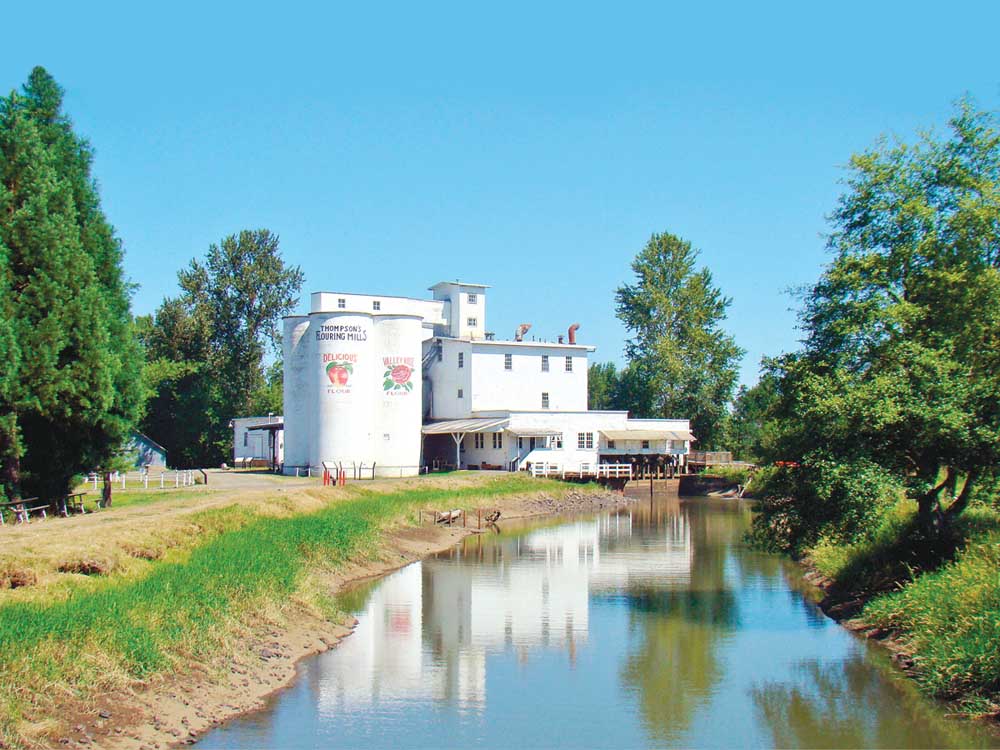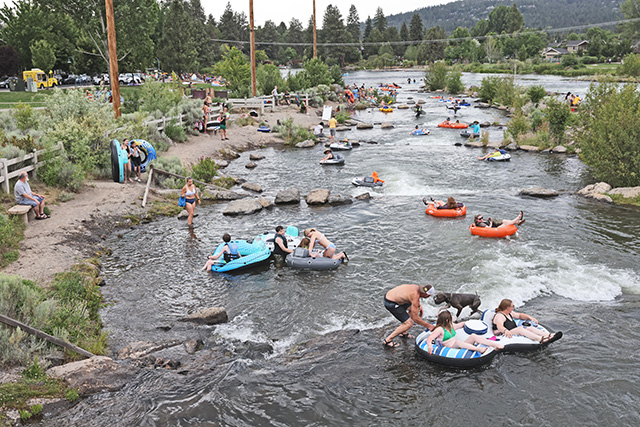Travel: Looping through Linn County
Published 12:00 am Sunday, August 10, 2014

- John Gottberg Anderson / For The BulletinThe Calapooia River millrace serves Thompson's Mills State Heritage Site near Shedd. Oregon's oldest surviving water-powered mill was built in 1864 to process flour, then was restored by the Oregon Parks and Recreation Department and opened to the public in 2007.
SWEET HOME — For Oregon’s legion of country music lovers, there’s no place like Sweet Home.
For 22 years, normally serene Sankey Park, two hours’ drive west of Bend, has been the home of the premier country music festival in the Pacific Northwest. The Oregon Jamboree sets up beside the historic Weddle Covered Bridge during the first weekend of August, inviting families to camp in tents and RVs on 20 acres close to the dual stages.
{%TravLinn-p01 081014%}
Here, they have a chance to mingle with such famed artists as Tim McGraw and Miranda Lambert, who headlined the 2014 show, and Keith Urban, who already has been announced for 2015. There’s plenty of food and drink available, and between or before performances, scores of artists and craftspeople exhibit their finest work.
But an exploration of western Linn County need not be restricted to three days in August. Throughout the region — from Sweet Home to Albany, Brownsville to Harrisburg and beyond — towns small and large offer attractions to entice back-roads travelers at any time of year.
For instance, in Sweet Home, the first town of size (9,000 citizens) for travelers westbound on U.S. Highway 20 over Tombstone Pass, the East Linn Museum is open every month but December and January.
{%TravLinn-p02 081014%}
Housed in a former church, it has a thoughtfully displayed collection of artifacts dating from the earliest pioneer settlement on the Santiam River, in 1852. On an old piano sits the sheet music to Paul Zastrow’s “Where the Santiam River Flows”; I wondered if Wynonna Judd or any other early Jamboree headliners had performed it.
Sweet Home’s biggest recreational draw is Foster Lake. Highway 20 traces its southern shore as it approaches from the east. About 3½ miles long, the lake was created in 1968 by the damming of the South Santiam River at its confluence with the Middle Fork of the Santiam. Several county parks in deep fir forests surround the lake, popular for water sports of all kinds, including boating and fishing.
{%TravLinn-p03 081014%}
‘Stand by’ Brownsville
Linn County’s most historical town is home to a mere 1,700 people. But all of central Brownsville is a designated National Historic District, preserving its red-brick architecture with an ample amount of civic pride.
Located astride the Calapooia River, a Willamette River tributary, Brownsville was established in 1846. First known as Kirk’s Ferry, it was renamed in 1856 (after a covered bridge replaced the ferry) to honor one Hugh Brown, who built its first general-merchandise store.
A woolen mill built in 1862 put Brownsville on the map. For 93 years, until it was destroyed by a fire in 1955, the mill turned out some of the highest-quality woolen products in the country. In 1884, in fact, it won first prize for blankets at a world’s fair in New Orleans.
In 1880, a narrow-gauge railroad first reached Brownsville’s thriving industrial sector — home not only to the woolen mill, but also a grist mill, a sawmill, a tannery and a furniture factory. Several buildings survived a major 1919 fire, among them the Brownsville General Store, now the Corner Cafe. Built in 1874 at the southwest corner of Main Street and Standard Avenue, it is the town’s oldest existing wooden commercial building. At the head of Main Street, Carlson’s Hardware was built in 1903 as Brownsville’s first brick building; the lower floor has always been a hardware store, the upper story a fraternal lodge.
Brownsville’s more recent claim to fame is “Stand by Me,” the cult 1986 movie starring River Phoenix and Corey Feldman, directed by Rob Reiner and based upon a Stephen King short story. Much of the movie was filmed in and around this town, with cinematography by Bend resident Thomas Del Ruth. A Historic Brownsville brochure gives directions to 14 locations.
You’ll get all the information you want about Brownsville at the Linn County Historical Museum, which occupies an 1895 railroad depot a half-block off Main Street. The museum flows into an adjacent boxcar and caboose, featuring replicas of a general store, a bank, a barber shop and a milliner’s shop.
Across Main and a block south is the Moyer House, a beautifully preserved house built in 1881 by John and Elizabeth Brown Moyer, she the daughter of the town’s namesake.
{%TravLinn-p06 081014%}
Inspired by Italianate villa-style architecture, it was restored in the 1960s and today can be viewed on organized tours offered weekend afternoons.
About the only thing Brownsville doesn’t have is a covered bridge. But there are nine in different parts of Linn County. Nearest is the Crawfordsville Covered Bridge, built seven miles east of here in 1932; although it was bypassed by state Highway 226 about 50 years ago, it remains a roadside landmark.
{%TravLinn-p04 081014%}
Historic agriculture
West of Interstate 5 and east of the Willamette River, towns like Harrisburg, Halsey and tiny Shedd once thrived in a rich agricultural floodplain. The Harrisburg Area Museum, in particular, preserves memories of those halcyon days of the late 19th and early 20th centuries.
Only 3,600 people live in Harrisburg today, but the town once a regional hub. The museum was launched about 20 years ago with the restoration of the 1867 James McCartney House, now one of a half-dozen separate buildings on site — among them a school (with an archival library) and a chapel.
I found that two collections hold special interest. The exhibit of antique farm equipment, including tractors, cars, trucks, threshers and combines, was an eye-opener. Its highlight is a 50-horsepower Case steam tractor, built in 1916, that comes out of the garage every year for Harrisburg’s Old-Fashioned Fourth of July parade.
{%TravLinn-p10 081014%}
Fascinating in an entirely different way is the Bruce Witmer collection of scale models of historic buildings, each of them intricately hand-crafted of wood. The artist’s depiction of the Crater Lake Lodge holds center stage, but I was also intrigued by his depiction, in minuscule detail, of what Noah’s Ark may have looked like inside.
Halfway to Albany via state Highway 99 East, on a side road 1½ miles east of Shedd, Thompson’s Mills State Heritage Site rises above the Calapooia River like a ghost from another era — which, in fact, is what it is. Its white silos, now advertising “Delicious Valley Rose Flour,” have been a landmark of Oregon’s oldest surviving water-powered mill since the 1860s.
Through the era of World War I and the Great Depression, this mill steadily processed local wheat and other grains, shipping it as far away as China and western Europe. After World War II, as more families began buying their bread in stores and farmers changed their crops to grass seed, the mill’s owners switched to producing animal feed. In the 1980s, the mill began generating electricity for a local utility.
Thompson’s Mill and its water rights were sold in 2004 to the Oregon Parks and Recreation Department, which restored the buildings and opened them to the public in 2007. The site is a worthwhile stop for travelers interested in a rare glimpse at the lives of 19th-century mill keepers and area farmers. Interpretive panels also describe the intricate system of waterways, dams and control gates that bring the Calapooia River to the millrace.
{%TravLinn-p11 081014%}
Albany’s carousel
Take a single step through the door of the working studio of the Dentzel American Carousel Museum & Albany Carousel Studio, and you’ll be greeted by a menagerie of hand-carved wooden animals of all colors and species.
There are horses, of course, but also cats and dogs, giraffes and frogs, reindeer and dragons. These animals stand, in various poses, in a series of large rooms at the corner of First Avenue West and Washington Street, little more than a stone’s throw from the confluence of the Calapooia and Willamette rivers.
Many of them are fanciful, with designs such as a ringtail lemur swinging along the side of a bright-orange quagga (an extinct zebra), or a calico cat chasing a mouse across the back of a white poodle. The project, however, is no mere whimsy. It was launched in 2003, after the Dentzel family — which introduced carousels to North America in the 19th century — donated a 1909 spinning mechanism to the project and loaned several antique animals for study.
Welcomed at the workshop with open arms, visitors can imagine what may be Albany’s premier attraction several years from now, when the carousel may be completed. When completed, the Brass Ring Carousel will have 52 animals — each requiring more than 2,000 hours, or about a year, to carve from basswood (from the linden tree) and another 400 hours to be properly painted.
{%TravLinn-p14 081014%}
The project has become a civic focus for Albany’s 51,000 people, who also are proud of continuing preservation efforts in four national historic districts. More than 700 historic homes and buildings, from the downtown business district to block after block of residential neighborhood, lend an environment of pioneer heritage to Albany that few other Oregon communities can match.
The oldest house in Albany, and one of the earliest wood-frame buildings in the state, is the Monteith House. Built in 1849 by founding fathers Walter and Thomas Monteith, it is today a museum located barely a block from the carousel gallery.
When the Monteith brothers built their house, it straddled the dividing line between two 320-acre claims. They placed bedrooms on opposite sides of the house so as to satisfy a law requiring a land owner to sleep on his property. Together, the Monteiths plotted a 60-acre townsite and named it Albany, after the capital of their home state of New York.
The Monteith House today anchors the 73-square-block Monteith National Historic District, largest of Albany’s four heritage neighborhoods. House styles are distinctive and well known to architecture lovers: Federal, colonial revival, Queen Anne, Italianate, Eastlake, craftsman, bungalow and many more. The story of Albany’s historic neighborhoods is well illustrated downtown at the Albany Regional Museum, in an 1887 Italianate-style building at Second Avenue and Lyon Street.
Also downtown, opposite the carousel exhibit in a former body-and-fender shop on First Avenue, is Sybaris, easily the best restaurant along the Interstate 5 corridor between Portland and Eugene. Chef Matt Bennett, a James Beard award nominee, changes the menu monthly to craft creative recipes around products he can buy fresh locally.
{%TravLinn-p12 081014%}
Cedars of Lebanon
Lebanon, midway between Albany and Sweet Home on Highway 20, was settled by Oregon Trail emigrants in the 1840s. A merchant named Jeremiah Ralston, who opened the first store in 1847, named it for his birthplace of Lebanon, Tenn., and for the wealth of cedar trees beside the Santiam River on the east side of town: He was reminded, he said, of the Biblical reference to the cedars of Lebanon.
Now a town of 16,000, Lebanon still has its river and its western red cedars, though assuredly not in the quantity that they once stood. The Santiam has spawned several parks along its banks, notably River Park, where youngsters run down a long pier at Gill’s Landing to launch themselves into the stream below the Grant Street bridge.
Plums, walnuts, hazelnuts and strawberries were stanchions of the agricultural economy. The town celebrated its 105th annual Strawberry Festival in June, featuring a strawberry shortcake that it claims as the world’s biggest: It served more than 15,000 people.
The importance of logging has waned over the years, although several wood-products businesses persist. Perhaps the most apparent to travelers is Patrick Flanagan’s chainsaw wood-carving establishment, on Highway 20 just southeast of Lebanon.
{%TravLinn-p15 081014%}
From bears and sasquatches to loggers and cigar-store Indians, Flanagan seems to have covered all the rustic bases.
One roadside carving, in particular, caught my eye. A silvery alien being, perhaps 4 feet tall, motioned skyward with a raised arm and emotionless eyes. I had to stop the car and turn to see what it was pointing at.
Perhaps it was just a reminder that “The truth is out there,” as the old “X-Files” television show reminded us. But I like to think the entity was calling attention to the diversity of natural, historical and cultural attractions that are there for the curious traveler to uncover in western Linn County.
— Reporter: janderson@bendbulletin.com







